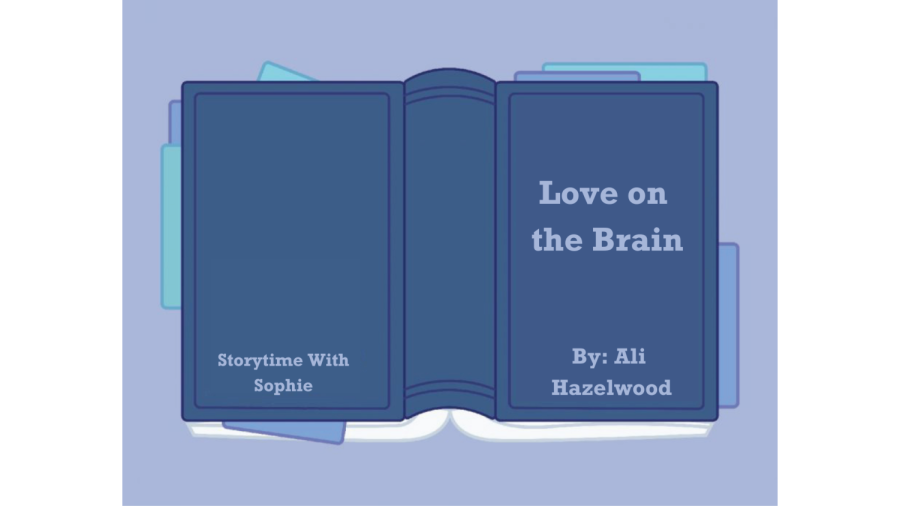Storytime with Sophie: Love on the Brain
Mediocre contemporary romance takes another victim! Today’s casualty: “Love on the Brain” by Ali Hazlewood. The novel was released on Aug. 23, as Hazlewood’s second published work, following her release of several novellas. All of her works follow the life of scientists and academia, with her newest release being no different.
The story revolves around the two scientists, being Dr. Bee Königswasser, and Dr. Levi Ward. The two contrasting personalities end up working as team co-leads on a project for NASA creating new technology.
This novel was highly anticipated considering the success of Ali Hazlewood’s first novel, “The Love Hypothesis.” All of Hazlewood’s works have found their way on social media platforms pertaining to books, such as the notorious “Booktok.” Many fans were eager for the work of Hazlewood and, depending on the reader, may have been disappointed.
The main characters are average, but nothing stands out. Bee’s main characteristics consist of being a Marie Curie fanatic and passing out often. Levi’s characteristics alter depending on the chapter, but overall consist of being awkward, desperately in love with Bee, and tall. Yes, his massive height is mentioned.
One of the novel’s biggest pitfalls is its unrealistic nature. Usually, this is something readers become accustomed to ignoring, putting logic on hold to enjoy the novel regardless. However, in the case of “Love on the Brain”, it becomes impossible to ignore. For the majority of the book, Bee maintains the perspective that she and Levi are “enemies” and believes that he harbors a deep dislike for her. This, to the knowledge of Levi, the in-world characters, and the reader themself, is completely untrue, and obviously show. The display of this highly educated woman who is so oblivious makes it all the harder to immerse into the story.
This book, as well as Hazelwood’s other works, take place in an academia, STEM setting. This both adds and hinders the overall atmosphere, because this decision is one that has an overarching effect on the novel as a whole. All conflicts, relationships, and resolutions must tie back into this specific niche, that the majority of readers are likely not familiar with, or to some extent even care about. Considering Bee and Levi are co-leading a scientific-engineering-NASA- astronauts project, scientific language and lingo is inevitable. This can sometimes drone on for those who do not have the same connection to neuroscience as the characters in the world do, creating very skimmable pages for the reader.
The characters themselves also fall within very stereotypical lenses. The main girl is quirky, “not like other girls,” and eccentric. The main guy is stone-faced but a softie once you get to know him (don’t worry, you will). Other characters such as Bee’s research assistant is described as emo and saying macabre bits of information whenever she so pleases. This very research assistant leaves her boyfriend for the pink, girly-girl who also works on the project, creating a somewhat forced representation that lacks authenticity.
The language used by the author is often cringe-inducing as well. The references to current-day media and phenomena fall flat, because readers often do not want to be reminded of TikTok, Twitter, and Elon Musk. The book is oddly political, with the politico affiliations of the characters, and therefore, the author, being made apparent.
The overall analysis of the novel can be summarized as, “eh.” The book is not bad, but does not bring anything new or innovative, to the slightly redundant world of romantic contemporary novels. This genre often contains two love interests who seem hard-pressed for love, but through a series of events and tribulations, they end up together, only for- gasp- the third act break-up. Following this bout of miscommunication of deceit, the couple always find their way back to each other. “Love on the Brain”, unfortunately, falls right for this trap of formulaic literature.
No element of the novel is completely unique to the genre. “Guys falls first” check, “forced proximity,” and potentially most aggravating, “miscommunication of feelings,” check. This repeated pattern of mediocre, overdone plots bears the question, how long will this work?
Despite the criticism toward the novel, it is important to note, the book is not bad. It brings up important discussions of women in STEM, the unfair nature of standardized testing, and the struggles towards underrepresented communities within education. The book works for what it is intended to be, a “feel-good” distraction of 368 pages, in which readers can immerse in tolerable writing and shenanigans for a few minutes of their day.

Sophie Barkett is a junior at Perry High. This is her second-year writing in the newspaper, and she is the Reviews/ Opinions editor. Her beats this year...


